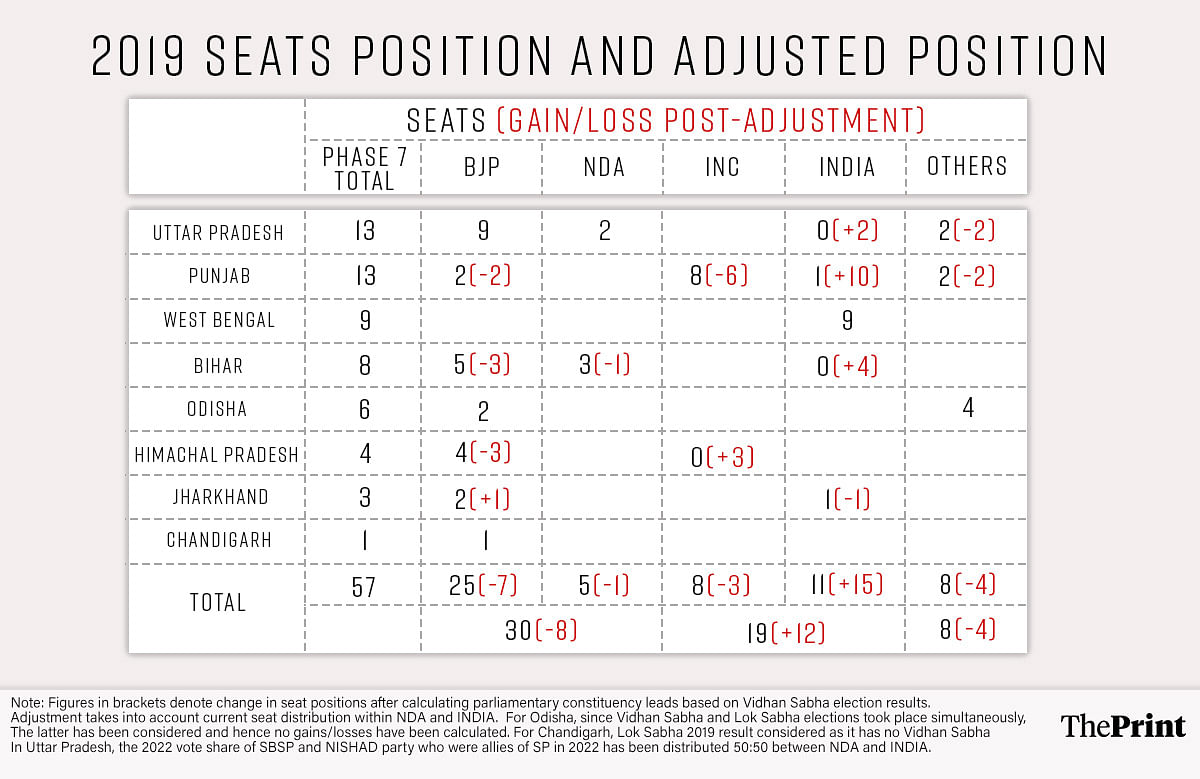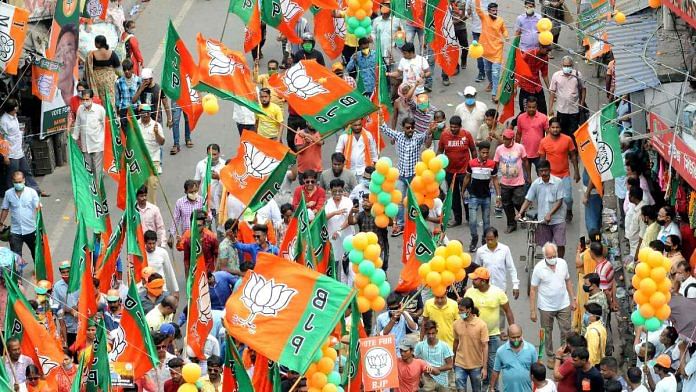The longest election in 72 years finally ends with polls in 57 constituencies across seven states and the Union Territory of Chandigarh. In three states — Uttar Pradesh, Bihar, and West Bengal — the drama has stretched over six scorching weeks and seven acts with ripples from each act echoing into the next. For Odisha and Jharkhand, this is the fourth and final phase; for Punjab and Himachal Pradesh, this is the only phase.
The seventh phase of the 2024 Lok Sabha elections comprises states and regions where the BJP needed to work to improve its tally. In 2019, the BJP-led National Democratic Alliance (NDA) had won only about half of the seats (30 of the 57) in this phase, while the INDIA bloc won 19 and ‘non-aligned’ parties won eight. The challenge for NDA is greater if seen in terms of the leads in Assembly elections post-2019 — by this account, the INDIA coalition stands to gain 12 more seats. However, the opportunity for NDA is also greater in this phase, especially in Odisha and perhaps in West Bengal.
You get a sense that this final phase, which includes Prime Minister Narendra Modi’s own constituency, was carved out for his undivided attention – the crescendo of what must have been imagined as a successful political campaign. It did not turn out that way.

States where INDIA stands to gain
The eight constituencies of the Bhojpur region in central Bihar—that the NDA swept in the last general elections—present a challenge to the ruling coalition. If we consider the 2020 Assembly elections in the state, the Mahagathbandhan, the local edition of the INDIA bloc, has more MLAs than NDA in six out of these eight Lok Sabha constituencies. This is partly because the Lok Janshakti Party, which was not a part of the NDA in the 2020 Assembly elections, had strategically fielded its candidates to cut into the votes of its current partner, the Janata Dal (United). Even if we go by the current coalitions, the INDIA bloc led in three constituencies: Jehanabad, Pataliputra, and Arrah. An additional two percentage point (pp) swing could take the INDIA tally to five seats.
Ground reports suggest that the INDIA coalition is well-positioned to realise this possibility. The Rashtriya Janata Dal (RJD) has announced a switch from its earlier strategy of ‘M-Y’ (Muslim-Yadav) to the new ‘A to Z’ approach, seeking to court all communities. This time, they have focused on giving more tickets to the substantial Kushwaha-Dhanuk communities—almost 7 per cent of the electorate—bringing them to their side at the expense of JD(U) and Upendra Kushwaha’s Rashtriya Lok Janata Dal (RLJD).
Further, RJD leader Tejashwi Yadav’s sharp campaign, with more than 200 rallies this election season, has focused on providing government jobs. His proof of delivery on this count in the 17 months he was the deputy Chief minister of Bihar has attracted young people across castes in this especially youthful state, where almost one out of three voters is between 20 and 30 years of age. Additionally, with its three committed candidates, ideological cadre, and appeal among the poorest, the CPI (Marxist-Leninist Liberation) has helped to consolidate the bottom of the pyramid in favour of the INDIA coalition, which the ‘Modi magic’ is insufficient to counter.
In Uttar Pradesh, the election ends in the 13 constituencies of Purvanchal. The NDA performed well here in both the 2019 Lok Sabha (11 seats) and 2022 Assembly elections, sweeping the regions surrounding Gorakhpur and Varanasi. The INDIA bloc won a majority of assembly segments in two constituencies: Ghazipur and Ghosi. The on-ground situation seems to be turning: despite the BJP’s alliances with Apna Dal (Sonelal), a Kurmi-centric party, Rajbhar-centric Suheldev Bharatiya Samaj Party (SBSP) and the Kevat-Nishad-centric NISHAD party, many important ‘ati-pichda’ or Extremely Backward Classes (EBCs) seem to be slipping from the NDA’s fold. It has helped that the Samajwadi Party (SP) has broadened its social coalition by offering more tickets to ‘Pichde’ (Backward Classes) and Dalits. Overall, 45 per cent of the NDA’s tickets in Uttar Pradesh have gone to upper castes, compared to 27.5 per cent for the INDIA bloc: the NDA once more seems upper-caste centric. For this last phase, if around one in six voters who preferred the NDA in the 2022 Assembly polls shift toward the INDIA bloc, the latter could win four more seats and increase its tally to six seats.
Punjab seemed to offer headroom for the BJP to grow, an opportunity that could not materialise. The farmers’ protest led to the split of the 25-year-old BJP-Shiromani Akali Dal partnership. Since then, the BJP has faced the wrath of rural Sikh farmers for its strong-armed approach to the protests. Its strategy of clawing a few seats by retaining the largest slice of upper-caste Hindu votes, adding Hindu and Sikh Dalits, and gaining acceptance among the Sikh voters with the help of Sikh leaders acquired wholesale from the Congress and the Aam Aadmi Party (AAP) has not worked. Instead of gaining, the BJP may end up losing one or both of the seats it holds in the state.
The main contest in Punjab is between the ruling AAP and the Congress, partners of the INDIA bloc that are fighting each other in a four or five-cornered contest. In a state where there has always been an implicit and at times explicit Sikh-Hindu divide, the Congress and the AAP are the only two parties that can win substantial votes from both communities. In 2019, the Congress won eight seats, while the BJP-SAD alliance won four of the 13 seats. The AAP, which secured just one seat in the Lok Sabha elections, went on to win four-fifths of the seats in the Assembly polls held in 2022, enough to give it a lead in 11 Lok Sabha seats.
Since then, anti-incumbency has set in, as the AAP has neither found the revenues to start its direct benefit transfer schemes nor has it been able to tackle the drugs and unemployment problems that have plagued the state for more than a generation. The Congress has asked some of its big leaders, including a former chief minister, a former deputy chief minister, and its current state unit chief, to contest Lok Sabha polls and enjoys an edge this time.
The relative leadership vacuum in Punjab has created space for radicals like Amritpal Singh, a fiery, young extremist currently in jail, to enter the electoral fray. It is hoped that this brush with electoral politics will moderate his stance and bring him into the mainstream. In the neighboring seat of Chandigarh, the Congress veteran, Manish Tewari has a sizable advantage and the support of AAP in a direct contest with the BJP.
In Himachal Pradesh, the Lok Sabha election has come as a relief for the Congress, and helped it pull itself together following the near-fall of the state government after six MLAs defied the party whip in Rajya Sabha elections of 2024. The Congress lost all four Lok Sabha Constituencies in 2019. If it holds on to the leads from the Assembly elections, it can wrest back Shimla and Hamirpur and even scrape through one more seat, Kangra, by combining its vote share with that of the AAP. On the ground, the Congress stands a better chance in Mandi, a seat it lost by a bigger margin in 2019 but won in a later by-poll. Here, a young ‘Rajasaheb’ Vikramaditya Singh, the son of Virbhadra Singh, the six-time CM of Himachal Pradesh, faces Bollywood star Kangana Ranaut, the BJP’s unstoppable fount of alternative WhatsApp histories and conspiracy theories.
In West Bengal, curtains fall on one of the most bitterly fought elections in recent times as this restive state seeks newer disequilibria. The BJP-dominated North Bengal and Junglemahal regions have already gone to polls; this phase, in and around Kolkata, is the citadel of Trinamool Congress (TMC), which has held each of these nine seats (by itself or through its allies) since 2009. In the Assembly elections of 2021, the Mamata Banerjee-led party won 62 out of the 63 assembly segments in these Lok Sabha constituencies. The BJP’s hopes rest on one of the two constituencies of Kolkata District – Kolkata Uttar or Kolkata Dakshin. The party has invested considerable resources, media hype, and the PM’s rallies to achieve a breakthrough here.
Though the BJP has succeeded in introducing a great deal of ideological churn and religious polarisation in Bengal’s strife-ridden but hitherto syncretic society, the TMC remains hard to beat in this region where Mamata Banerjee began her political career. The CPI(M), with its fresh faces and energetic new-generation-campaigning, could also upset BJP’s plans by taking away some of the anti-TMC votes. The BJP may find it hard to make up in this phase any losses that it may have incurred this time in its erstwhile strong areas.
Jharkhand offers a small opportunity to the INDIA bloc, which holds only one of the three seats that go to polls in the final phase. If we go by the 2019 Assembly election results, the present NDA would have led in all the three Lok Sabha seats. On the ground, however, it seems a close election with the INDIA bloc fancying its chances in all three seats, including Godda, where BJP’s loudmouth, Nishikant Dubey is running. The Jharkhand Mukti Morcha (JMM) is expected to do well in the two tribal seats, spurred by a spirited campaign by Kalpana Soren, wife of jailed former CM Hemant Soren.
Also read: Phase 6—gains and losses for BJP in east, setback in Haryana & Delhi
BJP’s stronghold in Odisha
If there is one state that offers assured gains to the BJP, it is Odisha. The state is witnessing an intense contest between the BJP and the Biju Janata Dal (BJD), the two parties that nearly formed an alliance before the 2024 elections. This last phase comprises six Lok Sabha constituencies mostly of coastal Odisha, where the BJP is hoping to make a breakthrough. The Congress is struggling to register its presence in even one seat. In 2019, the BJD won four of these six Lok Sabha seats and 33 of the 42 Vidhan Sabha seats. Unlike in Western Odisha, most voters here had voted for the same party in both the Assembly and the Lok Sabha elections. The BJD further consolidated its position in the panchayat elections held in 2022, when it swept the region.
The BJP needs to do well in this phase if it aims to improve its overall tally in the state. The party has chosen to hit hard with personal attacks on the popular Chief Minister, Naveen Patnaik, and his confidante, (Retd.) IAS officer VK Pandian, who is widely perceived to be Patnaik’s anointed successor. The Prime Minister has led the charge by flinging coarse conspiracy theories around the CM’s health. While this strategy is unlikely to work, the BJP may fare better for other reasons.
The reserved (ST) constituency, Mayurbhanj, is the home constituency of President Droupadi Murmu, now a much-loved icon in tribal Odisha: the BJP is expected to do very well here. The upper castes in the coastal districts may shift toward the BJP due to their shared dislike of VK Pandian, owing to his Tamil origins. Besides, the Prime Minister has some appeal among the Odia youth, who may also be attracted by the BJP’s job-centered campaign for the state. Ground reports suggest that while the BJD continues to dominate the Assembly elections, the BJP may succeed in wresting some Lok Sabha seats from the BJD.
All in all, in this last phase, both NDA and INDIA coalitions have areas of opportunity and vulnerability. Fingers crossed, as all parties await the next week with eagerness and anxiety.
Yogendra Yadav is National Convener of the Bharat Jodo Abhiyan. He tweets @_YogendraYadav. Shreyas Sardesai is a survey researcher associated with the Bharat Jodo Abhiyan. Rahul Shastri is a researcher. Views are personal.
(Edited by Ratan Priya)






